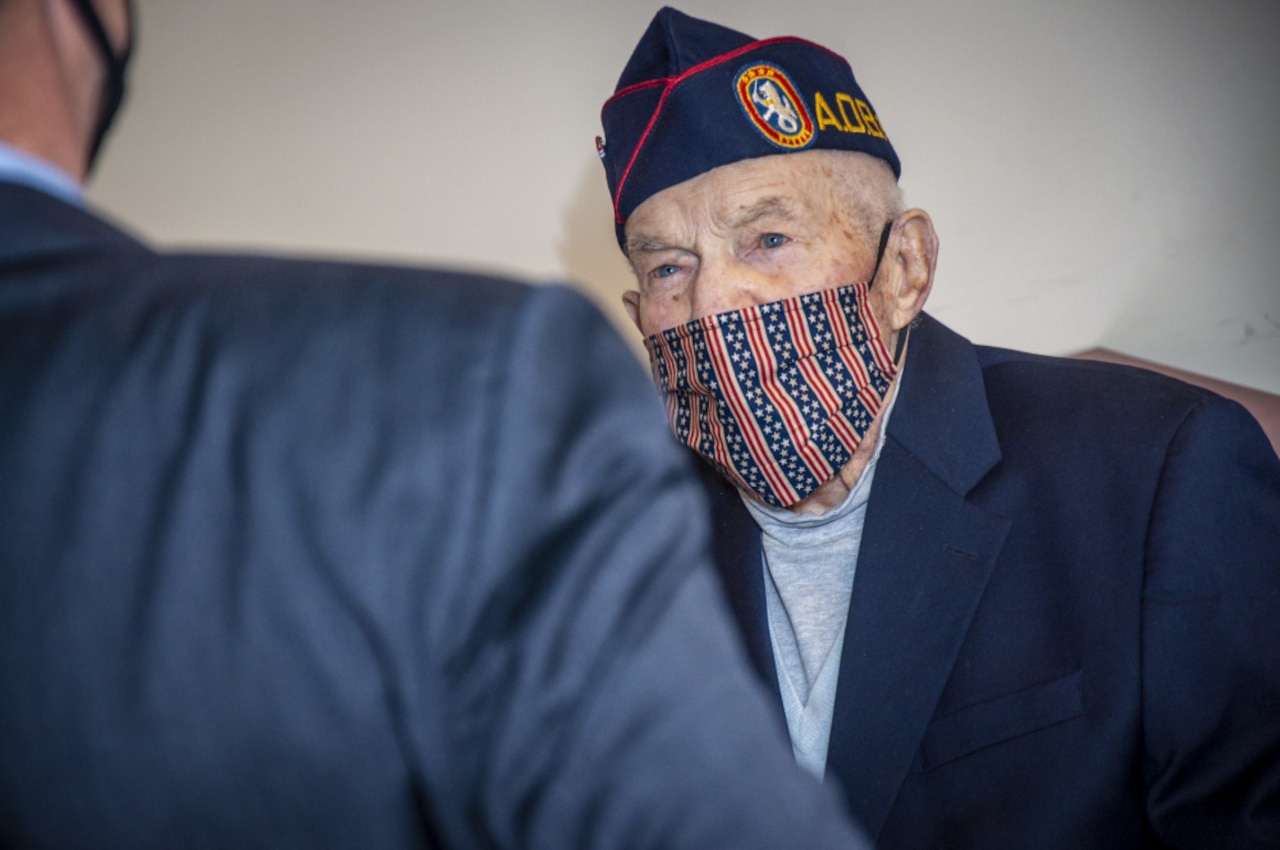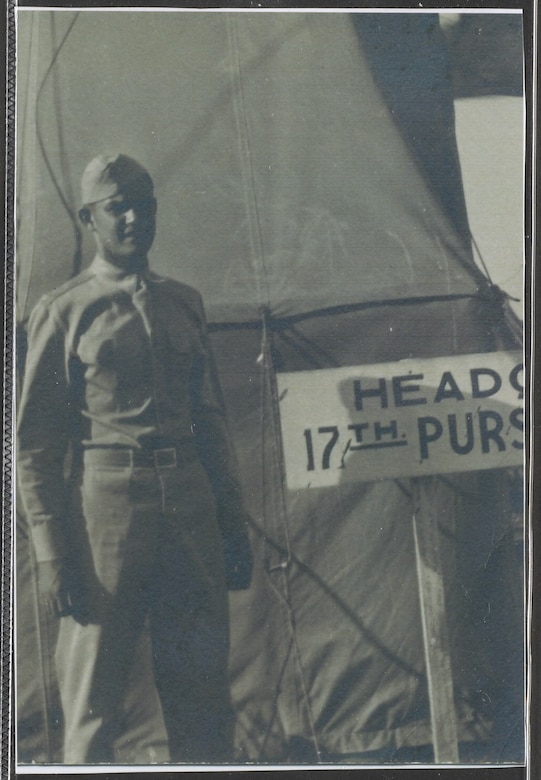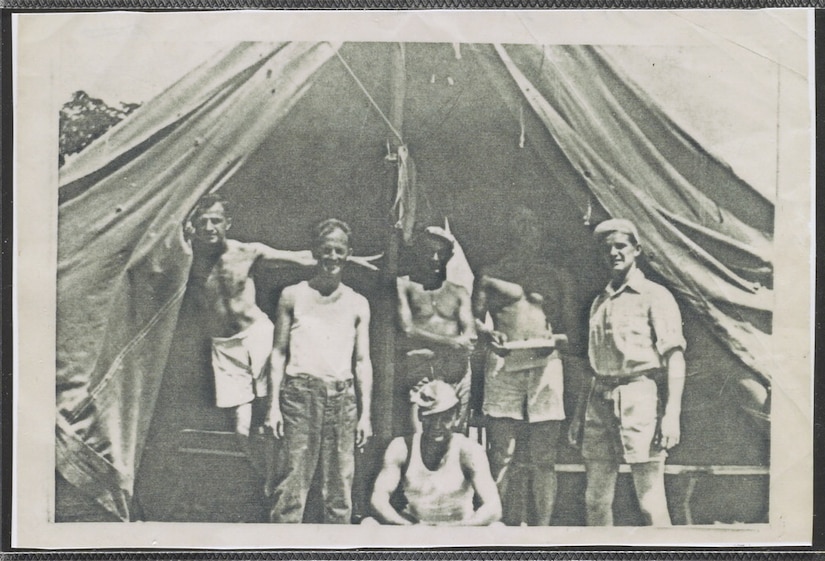An Army veteran who served in the Pacific theater in World War II was finally recognized for his courage in a ceremony on Jan. 4.
"Courage means to me that when the time came, that you were called upon to do the right thing, you did it," said Dan Crowley.
Crowley was awarded a Prisoner of War medal and an Army Combat Infantryman Badge; he was also promoted to sergeant.

At an Air National Guard hangar in Windsor Locks, Connecticut, Gregory J. Slavonic, who is performing the duties of the Navy undersecretary, presented Crowley with the long-delayed honors and recognition.
"I have to say that to be able to do this today is a rare and humbling opportunity for me as the undersecretary of the Navy — to be able to recognize Dan for his many sacrifices and accomplishments," Slavonic said. "He truly represents members of the greatest generation, who did so much but asked so little from their country. The valor and professionalism demonstrated by you, Dan, has earned you a permanent place in the heart of every American."
A Connecticut native, Crowley joined the Army Air Corps in October 1940 at the age of 18. For his first duty assignment, Crowley was assigned to an aircraft unit on Nichols Field near Manila, the capital of the Philippines. He arrived there in March 1941. At the time, the U.S. was not involved in the world war that had ravaged so many other nations. But after being on station in the Philippines for just nine months, things changed dramatically.
On Dec. 7, 1941, the Japanese bombed Pearl Harbor, Hawaii. The U.S. declared war on Japan the same day. The following day, the Japanese bombed the Philippines, as well, and they eventually made their way to Nichols Field where Crowley was assigned.
Crowley wasn't trained in combat arms, but when the bombs started falling, he and other soldiers had to act.
"Dan and his unit participated in an improvised air defense at this location, welding antiquated [British machine guns] together to form a single, more powerful gun," Slavonic said.
The Japanese raid at Nichols Field destroyed all the hangars, most of the aircraft, and other infrastructure. While Crowley and others worked to defend the airfield against the Japanese attacks, their efforts ultimately proved unsuccessful.

On Dec, 24, 1941 — about 15 days after the Japanese bombed Nichols Field — Crowley and others sailed about 25 miles across Manila Bay to the Bataan Peninsula in the dark of night, leaving their former home abandoned.
"The Japanese controlled the air over the Philippines, [and] completely eliminated the U.S. Far East Air Force as an effective defense of Asia," Slavonic said. "The Philippines now had to rely solely on its ground forces, which at the time had no lines of supply nor escape."
On the Bataan Peninsula, the fighting continued. The soldiers from Nichols Field — including Crowley — became part of the U.S. Army's Provisional Air Corps Infantry Regiment. The regiment was joined in their efforts by the Philippine Scouts.
"[They] worked hand-in-hand to fend off three amphibious landings by the Japanese on the west coast of Bataan in the Battle of the Points," Slavonic said. "Imagine the courage and determination it required for Dan to stay alive, yet remain engaged in these assaults."
After three and a half months of fighting, it was apparent the Japanese were going to prevail at Bataan. It was then, on April 9, 1942, the American leadership on the peninsula opted to surrender in order to prevent further casualties — something that had never before happened. As part of the surrender, they ordered troops to move south on the peninsula and congregate there in Mariveles.
While the U.S. forces had been ordered to surrender, Crowley wasn't in agreement with his leadership.
"The men did not surrender, either on Bataan or on Corregidor," Crowley said. "They were surrendered by their commanding officers to prevent a massacre, which was threatened by the Japanese commander."
Instead of surrendering, Crowley and others made other plans to escape the clutches of the Japanese.

"Refusing to become prisoners, he and a number soldiers and sailors hid among the rocks in the breakwater near the shore, and, at nightfall, they made their way through the three miles of shark-infested waters, swimming to Corregidor and clinging to lifeboats or debris from the various ships that were bombed or scuttled," Slavonic said.
On Corregidor island, just off the southern tip of the Bataan Peninsula, Crowley and others were met by a Marine Corps unit — the 4th Marines Regimental Reserves. Crowley and the others who had escaped Bataan fought alongside Marines to keep Corregidor from falling into the hands of the Japanese.
"These Marines fought a dangerous and desperate shore defense until Corregidor fell on May 6, 1942," Slavonic said. "Dan, along with nearly 1,200 other POWs, were held at the 92nd Garage Area on Corregidor, an exposed beach with little water or food and no sanitation."
By the end of the month, Crowley and others were taken by boat from Corregidor to Manila where they were paraded through the city as part of the "March of Shame" on May 25, 1942. Eventually, he was housed as a POW at Camp Cabanatuan.
"To escape the unspeakable conditions of the camp, Dan volunteered to work the airstrip in Palawan Island where he and other laborers were given only hand tools to carve out the runway for the enemy," Slavonic said.
On Palawan Island, Crowley worked for nearly 18 months to build a runway for the Japanese. He was eventually returned to Manila in February 1944, but not everyone who'd gone to Palawan Island was returned.
"[The Japanese] burned alive a hundred-plus Americans on the island of Palawan," Crowley said. "The Japanese proved their threat of massacre was not an empty threat. They did proceed to murder about 150 Americans by burning [them] alive with gasoline. They forced them to dig a long ditch ... they were forced into it, and then [the Japanese] poured gasoline on them and the guards ... they ignited it with torches. Some men actually survived, so we have eyewitness accounts to it."
Back in Manila, Crowley had escaped that death sentence, but the Japanese had other plans for him. To support the Japanese war effort, he was to mine copper as a slave laborer. In March 1944, the Japanese put him on a boat bound for Japan.
"[Dan survived] a hellish transit that would last for weeks, ultimately arriving in Japan," Slavonic said. "The stories of what transpired on those 'hell ships,' have driven many sailors, as Dan has said, to have all sorts of nightmares and post-traumatic stress disorder. Ultimately, Dan would spend three-and-a-half years as a prisoner of war, enduring the most unspeakable tortures, and witnessing many of his closest friends suffer the most inhumane murders of the war."
On Aug. 6, 1945, the U.S. detonated a nuclear weapon over the city of Hiroshima, Japan. Three days later, the U.S. detonated another weapon over the city of Nagasaki. On Sept. 2, 1944, the Japanese signed documents of surrender aboard the USS Missouri. Just two days later, Crowley was liberated. After spending some time in an American hospital, he was able to return home to his family in Connecticut.
Crowley was honorably discharged from the Army in April 1946; however, Army records show he had been promoted to sergeant in October 1945, but Crowley never learned of that promotion.
On Monday, Crowley finally received the chevrons of an Army sergeant — bringing him into the ranks of the noncommissioned officer corps. Recognizing the three and a half years he spent as a prisoner of war at Corregidor, Manila, Palawan and Japan, he was awarded a POW medal. And, finally, in recognition of the armed combat he participated in at Nichols Field on Bataan and on Corregidor, he was given the Army's Combat Infantryman Badge.
"As every generation learns, freedom is not free," Slavonic said. "This is Dan's story. Many others like it remind other service members of the dedication and service displayed by the greatest generation. We have an obligation to remember these brave men and women who fought so hard and expected so little from their nation."







No comments:
Post a Comment